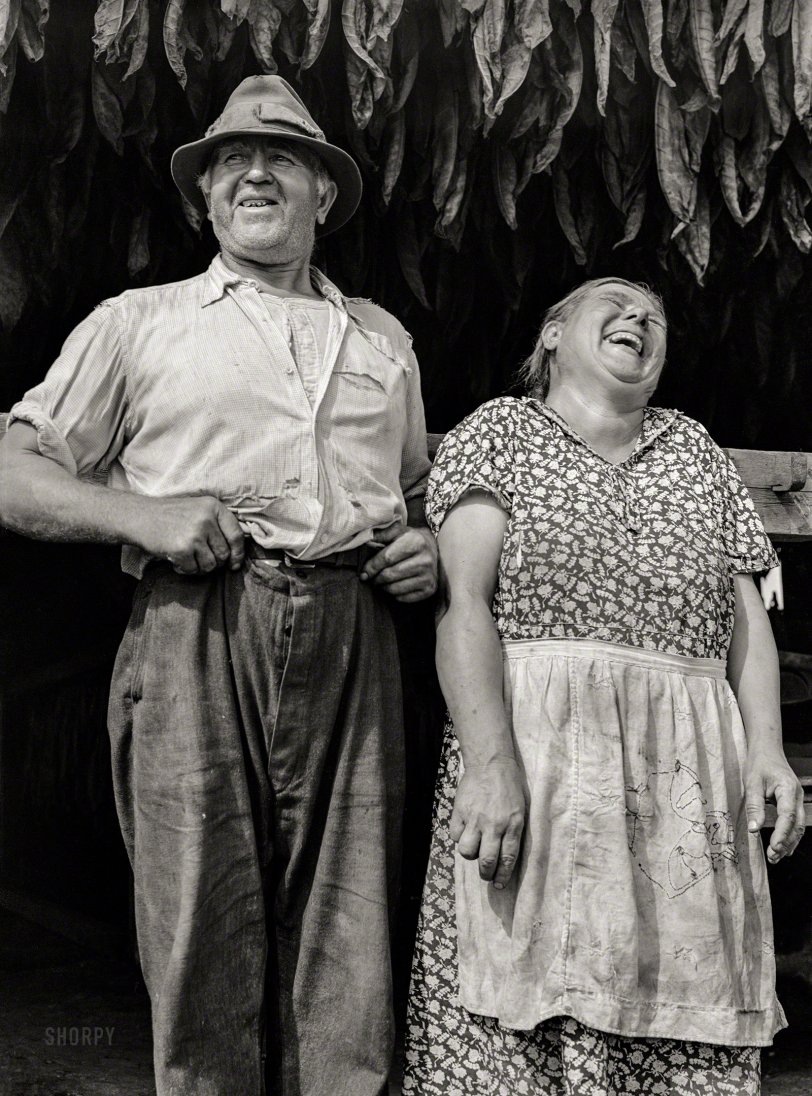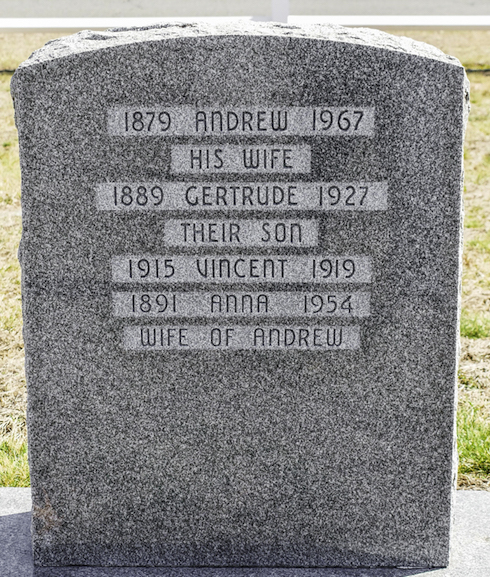


Framed or unframed, desk size to sofa size, printed by us in Arizona and Alabama since 2007. Explore now.
Shorpy is funded by you. Patreon contributors get an ad-free experience.
Learn more.

- Lofty addition
- In 1912
- Keenan Building
- Six years old
- Taken from the P.J. McArdle Roadway?
- It stood only 47 years
- Three track mind
- Incline to the right
- Reach for the sky, 1912 style
- No clean sweep
- Same Job Title, Same Face
- Sadly Lost
- Beautiful ...
- Where you get your kicks
- Aim High
- Pueblo Revival sisters
- Pueblo Neoclassicism
- Milk Man
- Regional dialect.
- Spielberg's inspiration
- Great Photo
- Loaf Story
- Do you still have the Rakes category?
- Could almost be a scene from the 1957 movie 'Hell Drivers'
- The Wages of Fear.
- Conspicuous by their absence
- Got Milk?
- All that aluminum
- No lefties
- Smoke 'em if you've got 'em
Print Emporium
Polish Jokers: 1940

Photographer Jack Delano explains that he made the couple laugh by telling Mr. Lyman his pants were falling down. "The thought of such a catastrophe," Delano writes, "apparently made them break up."
September 1940. "Mr. and Mrs. Andrew Lyman, Polish tobacco farmers near Windsor Locks, Connecticut." Medium format acetate negative by Jack Delano for the Farm Security Administration. View full size.
This is my neck of the woods.
I'm in Westfield, Mass. The Connecticut River Valley from Greenfield up near the VT border to New Haven CT when I was growing up was nothing but canopies of white netting. Thousands and thousands of acres of shade tree tobacco for cigar wrappers.
I'm of Polish heritage and my roots are about 10 miles from Lithuania. Grandparents' documents said Poland-Russia. My parents were 1st gen Americans. My dad picked tobacco and my mom worked in the sheds. Women and girls worked the sheds because this tobacco was for cigar wrappers and their hands weren't as callosed as males. The leaves were sown onto hangers that were then set up in the sheds. The sheds used to be everywhere. Many sheds still exist.
When I was a kid I think you could be 14 to work tobacco with your parents permission. I was game. My parents refused. Said it was some of the hottest and dirtiest work you could do. They had worked in factories and that was easier than tobacco. In later years, the farmers would bring in Jamaicans and Puerto Ricans to pick the stuff. Many stayed which is why there's such a large population (especially Puerto Ricans).
Nowadays when they pick it, I've seen a lot of places use conveyor belts that they set up between the rows. You pick it and stick it on the belt instead of carrying it to the end of the netting. The canopies could go on for an easy 800-900 ft if not more without a break.
I'm a Bing user. Search their images for "new england tobacco photos"
As if we needed proof
... that the best photos are the spontaneous ones. Jack Delano was a master at his craft.
Connecticut, the Nutmeg State
It always comes as a surprise to learn that tobacco is the Nutmeg State's number one cash crop, then and now - though nowadays less than then.
A Photo Well-Known to Me
This photo brings back memories for me! When my aunt returned to Maine in 1961 after living several years in our Ohio town, she gave me a book published by Look Magazine entitled Look at America. It was well-crafted coffee table book organized by geographical areas of the U.S. Compiled in the early 1950s, the book included photos from renowned black-and-white photographers of the time. Favorite pictures included the one above, a photo looking down on Harper's Ferry West Virginia from the heights across the river, and one of some kids frolicking in a pond in Maine. There was something familiar and comforting about this particular picture. Perhaps it was because my part of Northwest Ohio had a huge Eastern European population. These people could have been our neighbors...
Best place on Earth in 1940?
Whichever nationality was correct, they were among the luckiest members of their tribe to be on the other side of the Atlantic for the dawning epoch!
Tobacco Drying Barns
1960-70 (my age 5-15 years old) I would accompany my parents as they drove up from southern Connecticut to southern Vermont to visit Grandma. A lot of that time predated the completion of Interstate 91, especially in Massachusetts.
Along the Connecticut River in Northern CT & through MA I remember passing huge fields of tobacco and drying barns.
Here's an article about tobacco in Windsor Locks:
https://connecticuthistory.org/windsor-tobacco-made-in-the-shade/
Pioneer Valley tobacco
I went to school at UMASS/Amherst in the 70s. The surrounding Connecticut River floodplain used to be full of tobacco fields and sheds. The population has lots of Polish and French last names.
Shade grown tobacco was common
In the middle of the last century, likely before and after also, tobacco was grown under tent-like white sheets of what looked like gauze. The sheets were supported on poles(not Poles) above the growing plants, nearly 10 feet in the air.
I was informed that was 'shade grown tobacco', and was used to form the wrappers for cigars.
Windsor Locks is the locale where Bradley International Airport is located, from which I took my first flight, to NYC.
There was a lot of farm country in that area, with many tobacco growing farms, though I can't say what it looks like now.
tom
It's a wrap
As soon as I saw "Connecticut" I knew this was wrapper tobacco. As in the leaf rolled to make a cigar. Connecticut varieties need shade to prevent sunburn, often grown under light cover.
Connecticut shade-grown tobacco
In the cigar world, Connecticut is famous for its shade-grown tobacco, in which plants are grown under a thin cloth to exclude direct sun. Shade-grown Connecticut Broadleaf has a distinctive nutty, mellow quality that is all its own.
Other countries, like Ecuador, grow their tobacco on cloud-covered mountains to duplicate the filtered sunlight provided by the gauzy cloth.
Andrew and Anna's headstone
From Find a Grave
Saint Josephs Cemetery
Windsor, Hartford County, Connecticut, USA

Tobacco up north
I never knew until I saw the movie "Parrish" when I was about 12 that tobacco was grown north of Kentucky.
Lithuanian jokers, actually
Farther down in the comments section to which Dave links for the laughing-couple tale, I found the following (comment by esagys): "Actually they're both Lithuanians, his name was originally Andrius Limonas, according to his son. She was his second wife, Anna (Ona) Gailiunaite (my grandmother's sister), from Vabalninkas, near Birzai, Lithuania. Both are buried at St. Joseph's Cemetery on Route 75 near Bradley Airport."
[At various times during its history, Lithuania has been been appended to, confederated with or occupied by various larger nation-states, including the Soviet Union, Germany and Poland (e.g., the Polish-Lithuanian Commonwealth). Which is why many erstwhile Lithuanians (especially ethnic Poles) might identify as Polish. - Dave]
























On Shorpy:
Today’s Top 5